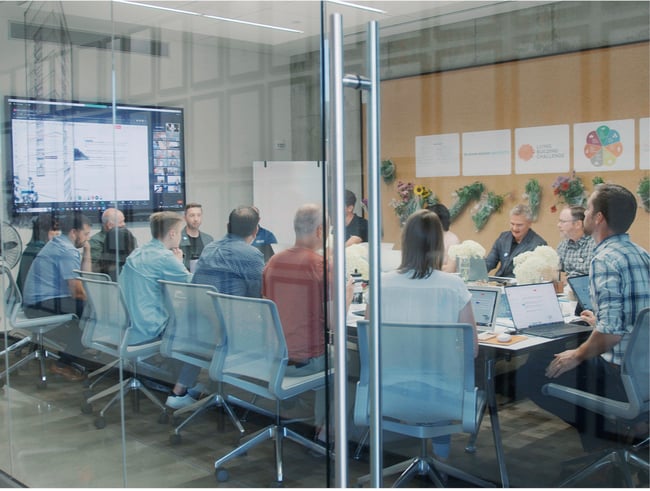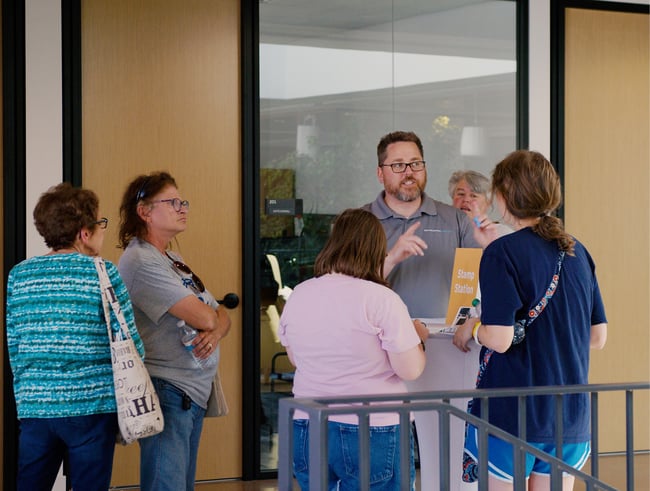5 Ways to Engage the Community on a Building Project

Community engagement is a cornerstone of a successful building project. For municipalities and public schools, it helps ensure the completed project meets local needs and provides necessary amenities. Similarly, engaging residents can help corporations and private clients build excitement for a project, attract talent, and cultivate community connections.
At Neumann Monson, we believe successful building projects begin with collective buy-in. All stakeholders, including community members, should feel they have a voice in the design process and the opportunity to influence the outcome. We’ve helped many clients foster community connections through surveys and workshops, and now we are sharing our insights with you.
This article will discuss a few strategies you can use to engage your community during the design and construction process and how these strategies can strengthen your project.
Community Engagement Strategies on a Building Project
1. Community Surveys
One of the most straightforward and effective ways to engage the community during a building project is through surveys. Often, municipalities use surveys when developing master plans or planning buildings like libraries or recreation centers. This process helps the city and the design team better understand the community’s needs and what amenities they should offer.
Surveying is a collaborative effort between the client and the design team. Although the design team can create questions and analyze results, the client should be the one to share and promote the survey.
Questions can range from quantitative to qualitative. Some surveys may ask if residents would use potential spaces or features. Others may have more open-ended questions about the community’s needs.
The Stanley Center for Peace and Security took this open-ended approach by asking residents what they hoped to see from the new facility. Based on the feedback, the Stanley Center incorporated amenities like pedestrian seating, public art, and an urban agriculture plot that produces herbs and vegetables for a local non-profit.
The approach you take depends on your project and community. In any case, the results can help you set goals and ensure the project’s impact extends beyond your walls.
2. Visioning Workshops
Another way to engage the community is through a visioning workshop. This activity occurs during pre-design—the goal-setting phase before design work begins.
Typically, the workshop involves stakeholders from your organization. For example, schools may include teachers and administrators, and corporations may include representatives from different departments. Working in groups, project stakeholders will set overarching goals to guide design decisions.
Although most visioning workshops are internal, they can include the wider community. You may invite representatives from various community groups, like government officials, economic development groups, or community outreach organizations. Their input can provide a broader perspective, leading to project goals that extend beyond your organization.
Another approach is to invite community experts and ask them to present before the workshop. The National Czech and Slovak Museum & Library took this approach by inviting a local historian. This inclusion helped stakeholders better understand the history of the Czech Village in Cedar Rapids and its role in the broader community.
Similarly, during our Iowa City studio renovation, we hosted a Biophilic Exploration and invited a local ecologist. His perspective helped us connect the design to the landscape, influencing design decisions like urban lumber use.

Visioning and biophilic workshops can involve local experts.
In short, a visioning exercise can be more than an internal experience. Inviting community members or local experts can give your team a deeper understanding of your area’s history, ecology, and culture.
3. Listening Sessions
Once the design process is underway, it helps to host community listening sessions and get feedback. We recommend hosting these sessions early in the design process before any decisions are set in stone.
Typically, these sessions involve a town hall-style meeting, with you and the design team giving a short presentation about the project and its goals. The meetings may also include concept renderings to help attendees visualize the completed project.
After the presentation, the community can give online or written feedback. These sessions help everyone feel heard, increasing support for the project. It can also help you narrow your options when debating multiple concepts or approaches.
Similar sessions work well for schools planning a renovation or addition. School administrators may discuss the planned project and give tours of the current facility, helping the community understand the project’s importance. Although these sessions can benefit any project, they are especially important during a bond referendum campaign.
4. Groundbreaking Ceremonies and Open Houses
Community involvement can also continue through construction. One approach is to host a public groundbreaking ceremony to kick off construction and build excitement.
The Stanley Center for Peace and Security hosted a public event before construction—called the ‘Ground Healing” ceremony to celebrate the project’s sustainability goals. In addition to speeches and a tree-planting ceremony, the event included guided tours of the soon-to-be-renovated facility, the former Musser Public Library.
Center at Sixth in Des Moines hosted a similar ceremony on Juneteenth 2023. The facility will act as an incubator space for minority-owned businesses, and hosting the groundbreaking was an opportunity to raise excitement for the next chapter in the neighborhood’s history.
Along with building excitement, a groundbreaking ceremony can set expectations with neighbors. It makes everyone aware of the upcoming construction and any potential disruptions.
Some owners opt to host additional community events during construction. For example, we have worked with clients who have hosted beam signing ceremonies where community members write messages on the building’s last structural beam. Other projects have engaged local schools to include a time capsule behind a cornerstone.

Open houses are one way to engage the public after construction.
After construction, you can host a public open house with self-guided tours and local entertainment acts. These events connect residents to the project and ingrain the completed building into the community’s fabric.
5. Updates During Design and Construction
Lastly, we recommend updating the public on your progress during design and construction. Blog articles, videos, and livestreams of the construction site can maintain excitement for the project.
Some owners choose to go a step further by hosting tours during construction. Although these events require some coordination with the contractor, they can be a great way to continue in-person engagement with the community throughout the project’s lifecycle.
What Are Your Next Steps?
Every building project can benefit from community engagement. Surveys, visioning workshops, and listening sessions can help you understand how your project can positively impact residents.
Continued communication through groundbreaking ceremonies, building tours, and project updates helps maintain enthusiasm for the project during construction. For corporations and developers, this communication can help ingrain the project into the community and improve its success.
Along with the community, it’s important to get buy-in from your internal stakeholders. We recommend including those who will occupy the space daily in early design discussions.
Several activities—including empathy mapping, benchmarking tours, and visual listening exercises—can help you and your team form a clear vision for your project and set high-level goals. Learn more about these activities by reading about empathy-building activities in pre-design.